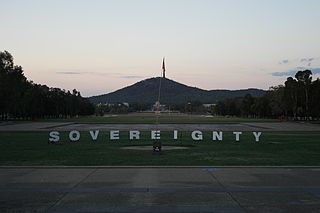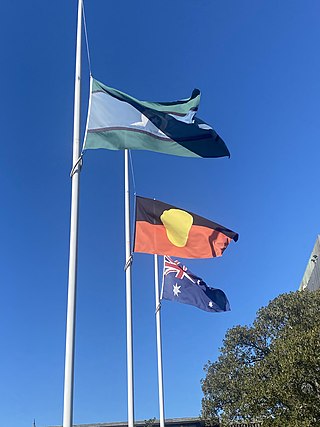
Mabo v Queensland is a landmark decision of the High Court of Australia that recognised the existence of Native Title in Australia. It was brought by Eddie Mabo against the State of Queensland and decided on 3 June 1992. The case is notable for being the first in Australia to recognise pre-colonial land interests of Indigenous Australians within the common law of Australia.

Australian Indigenous sovereignty, also recently termed Blak sovereignty, encompasses the various rights claimed by Aboriginal and Torres Strait Islander peoples within Australia. Such rights are said to derive from Indigenous peoples' occupation and ownership of Australia prior to colonisation and through their continuing spiritual connection to land. Indigenous sovereignty is not recognised in the Australian Constitution or under Australian law.

The Aboriginal Tent Embassy is a permanent protest occupation site as a focus for representing the political rights of Aboriginal Australians and Torres Strait Islander people. Established on 26 January 1972, and celebrating its 50th anniversary in 2022, it is the longest continuous protest for Indigenous land rights in the world.
Native title is the set of rights, recognised by Australian law, held by Aboriginal and Torres Strait Islander groups or individuals to land that derive from their maintenance of their traditional laws and customs. These Aboriginal title rights were first recognised as a part of Australian common law with the decision of Mabo v Queensland in 1992. The doctrine was subsequently implemented and modified via statute with the Native Title Act 1993.
NAIDOC Week is an Australian observance lasting from the first Sunday in July until the following Sunday. The acronym NAIDOC stands for National Aboriginals' and Islanders' Day Observance Committee. NAIDOC Week has its roots in the 1938 Day of Mourning, becoming a week-long event in 1975.
Indigenous land rights are the rights of Indigenous peoples to land and natural resources therein, either individually or collectively, mostly in colonised countries. Land and resource-related rights are of fundamental importance to Indigenous peoples for a range of reasons, including: the religious significance of the land, self-determination, identity, and economic factors. Land is a major economic asset, and in some Indigenous societies, using natural resources of earth and sea form the basis of their household economy, so the demand for ownership derives from the need to ensure their access to these resources. Land can also be an important instrument of inheritance or a symbol of social status. In many Indigenous societies, such as among the many Aboriginal Australian peoples, the land is an essential part of their spirituality and belief systems.
Indigenous Australian self-determination, also known as Aboriginal Australian self-determination, is the power relating to self-governance by Aboriginal and Torres Strait Islander peoples in Australia. It is the right of Aboriginal and Torres Strait Islander peoples to determine their own political status and pursue their own economic, social and cultural interests. Self-determination asserts that Aboriginal and Torres Strait Islander peoples should direct and implement Aboriginal and Torres Strait Islander policy formulation and provision of services. Self-determination encompasses both Aboriginal land rights and self-governance, and may also be supported by a treaty between a government and an Indigenous group in Australia.

Aboriginal title is a common law doctrine that the land rights of indigenous peoples to customary tenure persist after the assumption of sovereignty to that land by another colonising state. The requirements of proof for the recognition of aboriginal title, the content of aboriginal title, the methods of extinguishing aboriginal title, and the availability of compensation in the case of extinguishment vary significantly by jurisdiction. Nearly all jurisdictions are in agreement that aboriginal title is inalienable, and that it may be held either individually or collectively.

Michael Alexander Mansell is a Tasmanian Aboriginal (Palawa) activist and lawyer who has campaigned for social, political and legal changes.

R v Bonjon was a criminal court case, decided in the Supreme Court of New South Wales for the District of Port Phillip on 16 September 1841, in which Bonjon, an Aboriginal man, had been charged with murder for killing Yammowing, another Aboriginal man. The main issue in the case was whether the colonial courts had jurisdiction over offences committed by Aboriginal people inter se, that is, by one Aboriginal person against another.
An Aboriginal passport refers to various travel documents issued by the self-declared Aboriginal Provisional Government (APG), an indigenous Australian group. Such documents are not recognized as valid by the Australian government or its Australian Customs and Border Protection Service, although some people have been permitted to re-enter Australia using such documents. The documents are recognised as "fantasy passports" by the European Union.
Indigenous land rights in Australia, also known as Aboriginal land rights in Australia, are the rights and interests in land of Aboriginal and Torres Strait Islander people in Australia; the term may also include the struggle for those rights. Connection to the land and waters is vital in Australian Aboriginal culture and to that of Torres Strait Islander people, and there has been a long battle to gain legal and moral recognition of ownership of the lands and waters occupied by the many peoples prior to colonisation of Australia starting in 1788, and the annexation of the Torres Strait Islands by the colony of Queensland in the 1870s.
The Murrawarri Republic is a micronation that declared its independence from Australia in 2013, that claims territory and sovereignty over an area straddling the border of the states of New South Wales and Queensland within Australia. The territory is the traditional homeland of the Murrawarri people, an Aboriginal people, but the population of the territory claimed now comprises mostly non-Indigenous Australians. The Government of Australia has not acknowledged the declaration of independence, and their independence has been wholly unrecognised.
Indigenous or Aboriginal self-government refers to proposals to give governments representing the Indigenous peoples in Canada greater powers of government. These proposals range from giving Aboriginal governments powers similar to that of local governments in Canada to demands that Indigenous governments be recognized as sovereign, and capable of "nation-to-nation" negotiations as legal equals to the Crown, as well as many other variations.
Indigenous treaties in Australia are proposed binding legal agreements between Australian governments and Australian First Nations. A treaty could recognise First Nations as distinct political communities, acknowledge Indigenous Sovereignty, set out mutually recognised rights and responsibilities or provide for some degree of self-government. As of 2023, no such treaties are in force, however the Commonwealth and all states except Western Australia have expressed support previously for a treaty process. However, the defeat of the Voice referendum has led to a reversal by several state liberal and national parties in their support for treaty and a much more ambigious expressed position by state Labor parties and governments.
Aboriginal Australian identity, sometimes known as Aboriginality, is the perception of oneself as Aboriginal Australian, or the recognition by others of that identity. Aboriginal Australians are one of two Indigenous Australian groups of peoples, the other being Torres Strait Islanders. There has also been discussion about the use of "Indigenous" vs "Aboriginal", or more specific group names, such as Murri or Noongar (demonyms), Kaurna or Yolngu, based on language, or a clan name. Usually preference of the person(s) in question is used, if known.

Redfern Park is a heritage-listed park at Elizabeth, Redfern, Chalmers and Phillip streets, Redfern, Sydney, Australia. It was designed by Charles O'Neill. It was added to the New South Wales State Heritage Register on 21 September 2018.

Reconciliation in Australia is a process which officially began in 1991, focused on the improvement of relations between the Aboriginal and Torres Strait Islander peoples of Australia and the rest of the population. The Council for Aboriginal Reconciliation (CAR), created by the government for a term of ten years, laid the foundations for the process, and created the peak body for implementation of reconciliation as a government policy, Reconciliation Australia, in 2001.
The Wiradjuri Central West Republic is an unrecognized Aboriginal nation of Wiradjuri people, one of several such micronations that have asserted their autonomy within Australia as part of a separatist movement named the Sovereign Union. Declaring independence on 22 January 2014, at Wellington council chambers, the declaration served to assert the Wiradjuri people's inherent sovereignty, challenging the Australian government's authority and advocating for self-determination. It is the latest of a string of aboriginal declarations of independence on the continent, the others being: the Murrawarri Republic on March 30, 2013, the Euahlayi Peoples Republic on August 3, 2013, and the Republic of Mbarbaram.
APG Volumes 1–4 Sovereign subjects, Aileen Moreton-Robinson, Allen & Unwin, 2007; Let's Treaty Now, ATSIC publication








